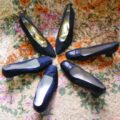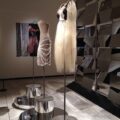Fashioned From Nature – Review
July 11, 2018Fashioned From Nature is the V&A’s (very successful) attempt to trace the relationship between fashion and nature. It encompasses more than 400 years of nature used as inspiration, nature used as decoration, nature threatened by fashion and mankind’s belated realisation of this and attempts to save it. “Green” fashion is by no means a new thing, as this exhibition shows.
In a way, this exhibitions remit is so broad it could apply to the design of any object, and not just clothes. Everything mankind produces either utilises natural substances or affects them in some way. “Buildings and Nature” would work, and we could talk about how people used to live in natural caves before graduating to huts constructed of natural materials like mud, moving on to bricks which are baked mud and how steel for skyscrapers nowadays is no doubt polluting the environment, and how some buildings are inspired by ants nests, or, I don’t know, “Axes and Nature”, starting off with prehistoric flint specimens and going through the process in the same way.
However, the theme here is fashion and since the V&A has great fashion archives, it’s handled very well. The ground floor deals with the subject from the 1600s to the late 19th century, dealing mainly with the Victorian period. The upper floors are 20th century onward.
Fashioned From Nature
It is startling and quite revolting how many fashion objects involving dead animal parts can be displayed together in one room. Right off the bat we have a corset, umbrella and riding crop made with whalebone, and fans and accessories made with ivory from elephants, tortoiseshell and mother of pearl, which is the inside of a type of mollusc shell. A little display in the Fashioned From Nature exhibition shows how silk is made from silk moths, and a historical silk court dress is decorated not only with actual ermine tails, but the fabric design features ribbons decorated with ermine tails, too. Ermine is a kind of stoat (in case you didn’t know, one is stuffed in a display case behind the dress). Their use in clothing was very expensive, because ermine are small, therefore prestigious. On this dress, I can count at least twenty ermine tail tips.
While we generally shy away from wearing fur now, silk is still highly desirable and in production. Perhaps because it comes from an insect, not a mammal, we generally try not to think about where it came from. The V&A Fashioned From Nature exhibition shows us several beautifully embroidered silk items whose design is inspired by the natural world. A French18th century man’s waistcoat stands out, delicately embroidered with macaque monkeys. The craftsperson probably never saw a real monkey, but a fascination with natural history in the period lead to exotic animals becoming motifs alongside more familiar european flora and fauna. A bed hanging uses immaculately embroidered caterpillars punctuated with snails and butterflies to create a grid enclosing fruits and flowers. Fragments of peacock feathers were used to make the insects iridescent.
Fashioned from nature – birds
Ah, feathers. Nowadays we don’t use feathers much, apart perhaps from a joke feather boa for hen parties (although, like fur, its use is on the rise on catwalks). There is a reason feathers aren’t so popular. The V&A has dug out a Victorian black feather cape so dramatic it looks straight from a pop performer’s stage costume. But donning it would make the wearer look rather bird-like themselves, as is skewered in the accompanying Punch cartoon entitled “A Bird of Prey” where a remarkably similarly attired matron speaks her wings to pounce upon a small bird.
Feathers were used on hats, in boas, in fans and as trimmings on dresses and outerwear. Of course, feathers could be plucked without essentially harming the bird and ostrich farms were developed for this purpose. However most birds were simply slaughtered, and often to only the adult birds died but their chicks would also starve to death without a parent to feed them. Grotesquely not only the feathers but the whole birds were uses on hats, fans and accessories. (Alexander McQueen re-used this idea more recently to shocking effect). In Fashioned From Nature, there is a pair of earrings made from humming bird heads.
Formation of the RSPB
Revulsion towards this lead to the formation of the RSPB, the Royal Society for the Protection of Birds in 1891, who staged public demonstrations. Other pro-animal campaigns at the time included anti-fur adverts in Vogue. Reformers also worked to reveal the extent of the human rights abuses involved in the rubber trade. The cotton trade was based on slavery and even the most natural of dyes, like woad and indigo, fed into the waterways along with the soap used in the dying process. As fast as changes could be made, they were discredited as a viable alternative. For example, rayon was made as an alternative to silk in the early 20th century. Cellulose was an early plastic. Both are made from wood pulp but the chemicals needed to break it down were, and are, toxic.
Fashioned From Nature today
This same problem exists today. At least in the past clothing was a highly valued commodity, and often even the court dresses of extremely rich people were re-worked to fit with latest trends. People did not simply throw clothing away. But now of course, clothing is produced at great volume and the struggles to make it at least environmentally friendly are documented on the top floor.
Designers like Christopher Raeburn with his work made out of old silk maps, G-Star Raw with their organic denim range, and various companies with vegetable alternatives to leather are shown, such as pineapple fibre or mushroom “leather”. Also documented in Fashioned From Nature are modern environmental protests.
It is a thorough show, with much to learn from, but its clear that the struggle to reconcile fashion and nature has been going on so long that an answer won’t be reached any time soon.
Fashioned From Nature is at the V&A Museum until 27th January 2019.
Fashioned From Nature Exhibition – Earrings made from heads of Red Legged Honeycreeper birds, circa 1875 © Victoria and Albert Museum, London
Detox Catwalk in Bandung
Greenpeace printed cotton t-shirt, Britain, 1990s, shown at Fashioned From Nature
Embroidered silk waistcoat, France, 1780-9. Image Vee Speers © V&A, shown at Fashioned From Nature
‘Grape’ dress (detail) made with Vegea, a leather alternative made from grape waste © Vegea, shown at Fashioned From Nature








